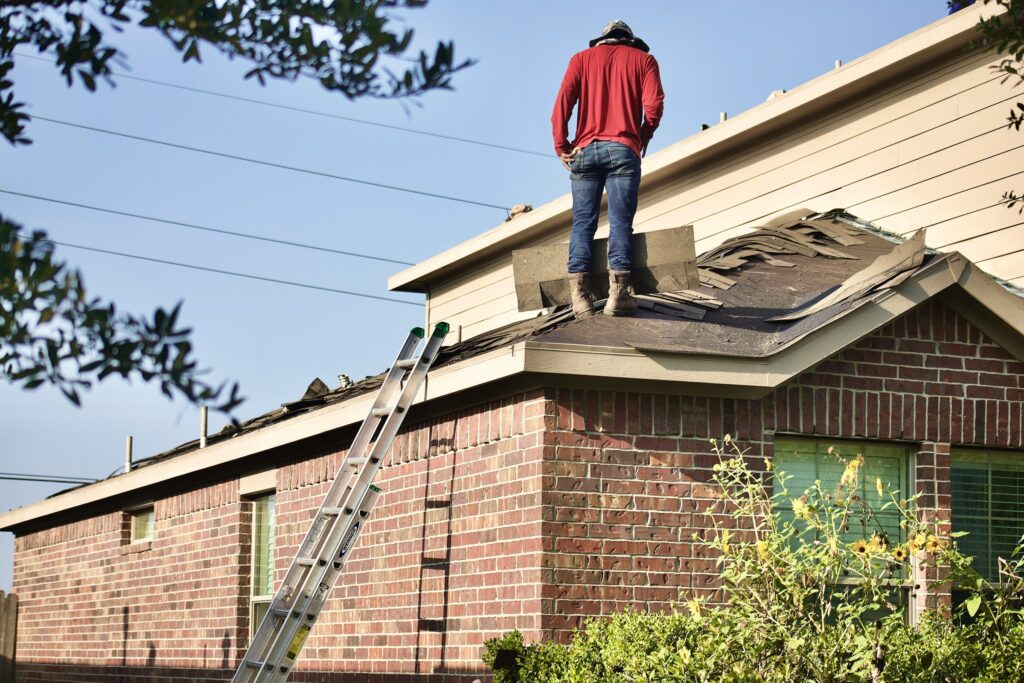These are the Essential Steps to Ensure Quality, Credentials, and Peace of Mind
Picture this: you’re curled up in your favorite chair with a good book, listening to the rain gently tap against your roof. Everything seems fine—until you spot a slow but steady drip coming from the ceiling. It’s the kind of rude surprise no homeowner wants, yet it’s all too common. A solid roof is one of the biggest investments you can make to protect your property, so when things go wrong (or before they do), you want the best professional on the job.
Choosing a roofing contractor is about more than just comparing quotes or glancing at a flashy website. It’s about finding a trusted expert who can diagnose issues accurately, deliver quality craftsmanship, and leave you with peace of mind long after they’ve wrapped up their ladders. This guide will walk you through everything you need to know to ensure you pick the right person—or team—for the job.
Why the Choice Matters
Your roof is essentially a shield guarding your home from the elements. If that shield is compromised—whether by poor installation or lackluster repairs—you could be dealing with leaks, structural damage, and unexpected costs down the road. Investing the time to find a reputable, knowledgeable contractor isn’t just about solving today’s problem; it’s about safeguarding your home for years to come.
Long-term savings also come into play. A well-installed roof tends to last longer and require fewer repairs than one slapped together by a cut-rate contractor. If you pick wisely now, you’ll likely avoid having to sink extra cash into repeated fixes later. Plus, if you ever plan to sell your home, a robust, professionally installed roof can boost buyer confidence and potentially increase resale value.
Step 1: Start with a Little Research
Before hiring anyone, it’s smart to do some digging. Begin by asking friends, family, and neighbors if they have recommendations. This word-of-mouth approach often provides more candid feedback than anonymous reviews online. You’ll hear firsthand about timelines, workmanship quality, and how any issues got resolved.
Online resources come in handy too. Checking community forums or local social media groups can reveal which contractors consistently get rave reviews and which ones homeowners have learned to avoid. Once you’ve assembled a shortlist, hop onto professional directories and websites to see if these contractors have any accolades or notable certifications. It’s a bit like piecing together a puzzle: you want a consistent picture of reliability, expertise, and good customer service.
Step 2: Verify Licenses and Insurance
Never be shy about asking a contractor, “Are you licensed to work in this area?” and “Do you carry insurance?” A trustworthy pro will appreciate your diligence—and have the documents to back it up.
- Licensing: Requirements vary by state or municipality, so what’s valid in one place might not cut it in another. A proper license, however, typically means the contractor has demonstrated at least a minimum level of competence and knowledge of local building codes.
- Insurance: This comes in two main flavors—liability insurance and workers’ compensation. Liability covers any potential damage the contractor might accidentally cause to your property. Workers’ comp addresses injuries that happen on the job, ensuring you’re not stuck footing medical bills if an employee is hurt on your roof. If a contractor hesitates to provide proof, treat that as a red flag.
Step 3: Collect Multiple Quotes
While it’s tempting to run with the first contractor who offers a decent price, comparing at least three quotes is generally best practice. Don’t just look at the bottom-line number; also consider each contractor’s reputation, proposed materials, timeline, and warranties. A quote that’s suspiciously low could mean corners are being cut—on insurance, labor, or material quality. Meanwhile, the highest quote might come from a contractor using premium products or specialized techniques.
When examining estimates, ask for itemization:
- Materials: The brand, quality, and type of shingles or underlayment.
- Labor: The number of workers, their experience, and the projected timeline.
- Cleanup and disposal: Will they remove old shingles and stray nails?
- Permits or fees: Some municipalities require official permits for roofing work.
The more transparent they are, the better you can gauge if their proposal fits your budget and your expectations.
Step 4: Evaluate Communication and Professionalism
It’s easy to get dazzled by a slick website or a friendly voice on the phone, but pay attention to how the contractor handles the finer details. Do they respond to your messages promptly? Are they patient and courteous when explaining options? Good communication is crucial for any successful project, and roofing is no exception. From schedule changes to unexpected weather, a lot can happen that requires a heads-up.
Look for:
- Timely responses: If they’re inconsistent in getting back to you before you sign a contract, that might not improve once work begins.
- Clear explanations: You deserve to know why they’re recommending a particular roofing material or approach. A good contractor speaks in understandable terms, not cryptic jargon.
- Respect for your property: How they treat your home during an inspection can be telling. Do they make an effort to avoid damaging your landscaping? Do they tidy up any debris?
A contractor who goes the extra mile to keep you informed and comfortable is far more likely to deliver solid results and address issues quickly.
Step 5: Watch Out for Red Flags
Plenty of great roofing contractors are out there, but you should still remain vigilant for warning signs:
Storm Chasers
These are often out-of-town crews swooping in after severe weather, offering to “fix” roofs at low cost. They might pressure you to sign a contract right away, then vanish if problems arise. Steer clear of high-pressure sales tactics or contractors who knock on your door uninvited.
Large Upfront Payments
While a partial deposit is common, a demand for the majority of the fee before the job starts can indicate financial instability. You might be paying for someone else’s ongoing project while yours gets delayed.
No Written Contract
A handshake might feel neighborly, but it leaves everyone vulnerable if something goes wrong. Even a straightforward job should have a contract covering scope of work, timeline, materials, warranties, and a payment schedule.
Reluctance to Provide References
Any reputable roofer should have a list of past clients who can speak to their professionalism. If they hem and haw when you ask for references, consider it a clue that something’s not right.
Step 6: Understand Materials and Warranties
One of the biggest decisions you’ll make is which roofing material to use. Asphalt shingles remain popular thanks to their affordability and decent lifespan, while metal roofing stands out for durability but costs more upfront. Tile, slate, or wood shakes each offer unique aesthetics, but your choice depends on budget, climate, and personal preference.
Always ask about the warranty—both manufacturer warranties on materials and the contractor’s own warranty on workmanship. Find out exactly what’s covered, for how long, and what might void that coverage. Reputable contractors typically stand behind their work, so if anything does go awry during the warranty period, you won’t be left scrambling to cover unexpected repairs.
Step 7: Put It All in Writing
After collecting quotes and verifying credentials, you’ll eventually pick your favorite. The next step is signing a contract. Think of it as your roadmap for the entire job. It should spell out:
- Project details: What specifically will be done—removing old shingles, installing new underlayment, adding flashing, etc.
- Costs and payment schedule: How much you’ll pay, when deposits or installments are due, and what triggers final payment.
- Timeline: When work will start, approximate end date, and how any weather delays might affect things.
- Warranties: Details on material and workmanship guarantees.
- Cleanup: Who handles disposing of old materials and tidying up stray nails or debris?
Take your time reading the contract. If anything is confusing or missing, ask for clarification. This step is your protection against misunderstandings, so it’s worth getting right.
Step 8: Know What to Expect During the Job
Roofing is often noisy and messy. Be prepared for early morning starts if the contractor wants to take advantage of cooler hours. You might need to remove lawn furniture, kids’ toys, or decorative items around the exterior to avoid any accidental damage. Some homeowners even choose to board their pets elsewhere to minimize stress from the commotion.
Key things to watch for:
- Crew behavior: Reputable roofers treat your property with care. While accidents can happen, they should take steps to protect windows, landscaping, and anything else at risk.
- Waste disposal: They should have a plan—dumpsters, tarps, or specific waste bins—for collecting nails, old shingles, and packaging.
- Daily updates: It’s helpful when contractors briefly let you know what was accomplished each day and what’s on deck for tomorrow.
Step 9: Final Walkthrough and Inspection
Once the last shingle is nailed in place, the contractor should invite you to join a final inspection. This step is essential to confirm the finished product matches the contract and your expectations. Check for consistent shingle alignment, secure flashing around chimneys or vents, and proper sealing of seams. Don’t hesitate to point out anything that feels off. Trustworthy pros will address your concerns and only consider the job complete when you’re fully satisfied.
It’s also a great time to confirm that all debris is gone, nails are picked up from your yard, and no stray equipment remains. Many roofers use powerful magnets to collect any nails that might have scattered during the tear-off stage.
Step 10: Plan for Maintenance and Potential Repairs
With a brand-new or newly repaired roof, you’re set for quite a while. Still, periodic checkups help ensure you don’t miss early signs of damage. Many homeowners make a habit of inspecting their roofs every spring and fall. If you live in an area with extreme weather—be it hail or heavy snow—extra vigilance is wise.
Remember, too, that gutters are closely tied to roof health. Clogged gutters can cause water to back up and seep under shingles. If your budget allows, consider investing in gutter guards or scheduling regular cleanings. Combining roof and gutter maintenance is a proactive way to keep your home’s entire “weather shield” in prime condition.
Common Challenges and How to Tackle Them
Insurance Claims
After severe storms, dealing with insurance can be a headache. If your contractor has experience in this area, they might help you navigate the paperwork. Keep receipts, photos, and any estimates well organized to streamline claims.
Budget Constraints
Roofing costs can add up. If finances are tight, ask about payment plans or financing. Some states even offer programs that help homeowners upgrade to more energy-efficient roofing systems.
Contractor Disputes
Occasionally, disagreements happen—maybe you’re unsatisfied with the final look, or they missed a detail. Document everything. Ideally, the contract covers what to do in case of disputes, but open communication often solves problems faster than legal avenues.
Local Regulations and Permits
Some municipalities have strict guidelines for roofing materials, color choices, or even the pitch of your roof. Make sure the contractor is up to speed on local codes so you won’t face fines or a forced redo.
A Quick Real-World Example
Let’s say you’re replacing your old asphalt shingles with a new metal roof for better energy efficiency and longevity. Contractor A gives you a rock-bottom quote, but doesn’t specify the brand of metal panels or mention any underlayment. Contractor B costs more, yet provides a clear breakdown, uses a well-known brand of steel, and offers references from similar projects in your area.
While Contractor A might save you money upfront, the lack of detail suggests potential corners being cut. Meanwhile, Contractor B’s transparency and proven track record indicate a higher chance of getting your metal roof done right. In the long run, the second option may save you from repairs or replacements, paying for itself in peace of mind and fewer headaches.
Find Roofing Support and Guidance
If you need more advice or want to verify that you’re working with a legitimate professional, these resources can lend a helping hand:
- Better Business Bureau
Search for BBB Accredited Roofers to discover contractors who’ve been vetted for ethical business practices. This is an excellent starting point if you want to see any past complaints or endorsements. - Angi (formerly Angie’s List)
Check out Roofing Contractor Reviews & Tips on Angi. You’ll find real feedback from homeowners who’ve worked with local pros, plus helpful articles that break down what to expect in a roofing project. - National Roofing Contractors Association
Browse the NRCA’s Why Choose an NRCA Member to learn how professional affiliations can signal a contractor’s commitment to industry best practices and ongoing education.
Using these resources can help you confirm a roofer’s credentials, ensure quality standards, and uncover additional tips for navigating your roofing needs.
Taking the Next Step with Confidence
A roof is so much more than a protective cover over your head. It’s a long-term investment in your home’s safety and comfort. When you choose the right roofing contractor, you’re not just solving an immediate leak or scheduling a routine replacement; you’re partnering with a professional who can guide you toward a stronger, better-protected home.
As you weigh your options, keep in mind the factors we’ve covered—recommendations, licensing, insurance, communication style, and materials. Trust your instincts if something seems off. And remember that the cheapest route isn’t necessarily the best one if it means sacrificing quality or peace of mind.
So go ahead: reach out to contractors, schedule estimates, and ask all the questions you want. When you finally sign on the dotted line, you’ll do so knowing you’ve laid the groundwork for a resilient roof—and a worry-free living space—well into the future.




